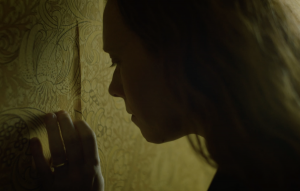 The Yellow Wallpaper is a short story written by Charlotte Perkins Gilman and published in 1892. It is formatted as the journal entries of a woman who, shortly after the birth of her child, has begun to suffer a mental decline. In an attempt to treat her condition, her husband has rented a summer home where he has confined her to the upstairs nursery. He heavily restricts her activities, forbidding her to write, work, or visit with friends, instead encouraging her to rest and breathe in the country air. The journal entries (which she keeps secretly) show the writer’s increasing hysteria as she begins to hallucinate a woman trapped inside of the wallpaper of the nursery.
The Yellow Wallpaper is a short story written by Charlotte Perkins Gilman and published in 1892. It is formatted as the journal entries of a woman who, shortly after the birth of her child, has begun to suffer a mental decline. In an attempt to treat her condition, her husband has rented a summer home where he has confined her to the upstairs nursery. He heavily restricts her activities, forbidding her to write, work, or visit with friends, instead encouraging her to rest and breathe in the country air. The journal entries (which she keeps secretly) show the writer’s increasing hysteria as she begins to hallucinate a woman trapped inside of the wallpaper of the nursery.
I chose to read this story in conjunction with The Bell Jar because, like The Bell Jar, it is written from the perspective of a woman experiencing a mental health crisis. Whereas Esther Greenwood suffers from depression and a series of suicide attempts, the narrator of The Yellow Wallpaper is entering into psychosis. These two stories are both interesting looks at the actual experience of disordered thoughts and the way that, to the person experiencing them, they are not only out of control, but completely rational.
Another similarity I noticed, which I did not expect, is that both stories have strong feminist themes, focusing on the way that women’s mental health is treated in society, particularly by men and male doctors. Esther’s condition is repeatedly downplayed by others throughout The Bell Jar, even by her male psychiatrist, who not only doesn’t take her seriously, but prescribes her shock therapy which is improperly administered at his own private hospital. The experience is incredibly painful and traumatizing for her. In The Yellow Wallpaper, the narrator’s husband is incredibly dismissive and considers himself the authority on her experience because he is a physician. He condescends to her and repeatedly insists that she is getting better even as she steadily declines. She recognizes her own state and tries to bring it up with him, but he argues that his course of treatment is really helping her because she has been sleeping and eating better. This scene is leads into the following exchange:
“… Really dear you are better!”
“Better in body perhaps —” I began, and stopped short, for he sat up straight and looked at me with such a stern, reproachful look that I could not say another word.
‘My darling,” said he, “I beg of you, for my sake and for our child’s sake, as well as for your own, that you will never for one instant let that idea enter your mind! There is nothing so dangerous, so fascinating, to a temperament like yours. It is a false and foolish fancy. Can you not trust me as a physician when I tell you so?”
So of course I said no more on that score, and we went to sleep before long.
To me, this is one of the best examples of the condescension and emotional control that characterizes the narrator’s marriage. The Yellow Wallpaper is a horror story because of this relationship almost as much as it is because of the obvious insanity aspect.